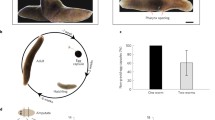Abstract
A chromosomal centric fusion polymorphism in populations of the plains pocket gopher, Geomys bursarius, was studied to determine the relative fitness associated with the karyotypic phenotypes. There was a greater number of heterozygous individuals than expected χ1 2=8.58, P=0.001. Calculations indicate that the viabilities of the two chromosomal homozygotes were only 35 and 76 percent or that of the heterozygote. Differences in fitness values for the chromosomal morphs for Geomys strongly emphasize the possible adaptive nature of the karyotype and provides a primary mechanism for chromosomal evolution, even in species composed of demes of relatively large size. This is the first case of positive chromosomal heterosis in vertebrates. The plains pocket gopher can now be added to the few empirically documented samples of balanced polymorphism.
Similar content being viewed by others
References
Atchley, W. R. & Woodruff, D. S., 1981. Eds. Evolution and speciation. Cambridge Univ. Press, New York. pp. 1–424.
Baker, R. J., 1967. Karyotypes of bats of the family Phyllostomidae and their taxonomic implications. Southwestern Nat. 12: 407–428.
Bengtsson, B. O. & Bodmer, W. F., 1976. On the increase of chromosome mutations under random mating. Theor. Popul. Biol. 9: 260–281.
Bickham, J. W. & Baker, R. J., 1979. Canalization model of chromosomal evolution. p. 70–84. In: Models and methodologies in evolutionary theory (J. H. Swartz & H. G. Rollins, eds). Bull. Carnegie Mus. Nat. Hist. 13: 105 pp.
Bush, G., 1981. Stasipatric speciation and rapid evolution in animals. p. 201–218. In: Evolution and speciation (W. R. Atchley & D. S. Woodruff, eds). Cambridge Univ. Press, N. Y., 424 pp.
Bush, G. L., Case, S. M., Wilson, A. C. & Patton, J. L., 1977. Rapid speciation and chromosomal evolution in mammals. Proc. natn. Acad. Sci. U.S.A. 74: 3942–3946.
Dobzhansky, T. H., 1970. Genetics of the evolutionary process. Columbia Univ. Press, N. Y.
John, B., 1981. Chromosome change and evolutionary change: a critique. In: Evolution and speciation, (W. R. Atchley & Woodruff, D. S. eds). Cambridge Univ. Press, N. Y., 424 pp.
John, B. & Lewis, K. R., 1957. Studies on Periplaneta americana. I. Experimental analysis of male meiosis. Heredity 11: 1–9.
John, B. & Lewis, K. R., 1958. Studies on Periplaneta americana. III. Selection for heterozygosity. Heredity 12: 185–197.
John, B. & Lewis, K. R., 1959. Selection for interchange heterozygosity in an inbred culture of Blaberus discoidalis (Serville). Genetics 44: 251–267.
Lande, R., 1979. Effective deme sizes during long-term evolution estimated from rates of chromosomal rearrangement. Evolution 33: 234–251.
Lewis, K. R. & John, B., 1957. Studies on Periplaneta americana. II. Interchange heterozygosity in isolated populations. Heredity 11: 11–22.
Lewontin, R. C., 1974. The genetic base of evolutionary change. Columbia Univ. Press, N. Y.
Patton, J. C., Baker, R. J. & Genoways, H. H., 1980. Apparent chromosomal heterosis in a fossorial mammal. Am. Nat. 116: 143–146.
Penney, D. F. & Zimmerman, F. G., 1976. Genic divergence and local population differentiation by random drift in the pocket gopher genus Geomys. Evolution 30: 473–483.
Sclander, R. K., Kaufman, D. W., Baker, R. J. & Williams, S. L., 1974. Genic and chromosomal differentiation in pocket gophers of the Geomys bursarius group. Evolution 28: 557–564.
Templeton, A. R., 1980. Modes of speciation and inferences based on genetic distances. Evolution 34: 719–729.
Templeton, A. R., 1981. Evolutionary change. Science 214: 900.
Vosselman, L. & Van Heemert, C., 1980. Meiotic disjunction and embryonic lethality in sex-linked double-translocation heterozygous males of the onion fly, Hylemya antiqua (Meigen) Theor. appl. Genet. 58: 161–167.
White, M. J. D., 1978. Modes of speciation. Freeman, San Francisco. 455 pp.
Wilson, A. C., Bush, G. L., Case, S. M. & King, M. C., 1975. Social structuring of mammalian populations and rate of chromosomal evolution. Proc. natn. Acad. Sci. U.S.A. 72: 5061–5065.
Wilson, E. O. & Bossert, W. H., 1971. A primer of population biology. Sinauer, Stanford, Conn., pp. 52.
Zimmerman, E. G. & Gayden, N. A., 1981. Analysis of genic heterogeneity among local populations of the pocket gopher, Geomys bursarius. In: Mammalian population genetics (M. H. Smith & J. Joule, eds), Univ. of Georgia Press, Athens. 380 pp.
Author information
Authors and Affiliations
Rights and permissions
About this article
Cite this article
Baker, R.J., Chesser, R.K., Koop, B.F. et al. Adaptive nature of chromosomal rearrangement: differential fitness in pocket gophers. Genetica 61, 161–164 (1983). https://doi.org/10.1007/BF00123719
Received:
Accepted:
Issue Date:
DOI: https://doi.org/10.1007/BF00123719




